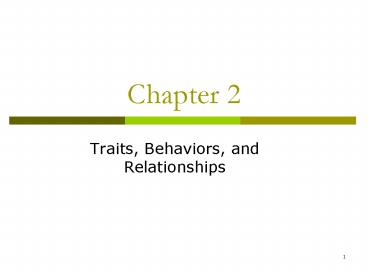Traits, Behaviors, and Relationships - PowerPoint PPT Presentation
1 / 18
Title:
Traits, Behaviors, and Relationships
Description:
Ex. 2.6 Leader Behavior Toward In-Group versus Out-Group Members. In-group ... Listens to employee's suggestions and ideas about how work is done ... – PowerPoint PPT presentation
Number of Views:49
Avg rating:3.0/5.0
Title: Traits, Behaviors, and Relationships
1
Chapter 2
- Traits, Behaviors, and Relationships
2
The Trait Approach
Traits the distinguishing personal
characteristics of a leader, such as
intelligence, honesty, self-confidence, and
appearance
Great Man Approach a leadership perspective that
sought to identify the inherited traits leaders
possessed that distinguished them from people who
were not leaders
3
Ex. 2.1 Personal Characteristics of Leaders
- Personal Characteristics
- Energy
- Physical stamina
- Intelligence and Ability
- Intelligence, cognitive ability
- Knowledge
- Judgment, decisiveness
- Personality
- Self-confidence
- Honesty and integrity
- Enthusiasm
- Desire to lead
- Independence
- Social Characteristics
- Sociability, interpersonal skills
- Cooperativeness
- Ability to enlist cooperation
- Tact, diplomacy
- Work-Related Characteristics
- Drive, desire to excel
- Responsibility in pursuit of goals
- Persistence against obstacles, tenacity
- Social background
- Education
- Mobility
4
- Self-confidence assurance in ones own
judgments, decision making, ideas and
capabilities - Honesty truthfulness and nondeception
- Integrity the quality of being whole,
integrated, authentic, and acting in accordance
with solid moral principles that are shared by
your constituents. - Drive high motivation that creates a high effort
level by a leader
5
Behavior Approaches
Autocratic a leader who tends to centralize
authority and derive power from position, control
of rewards, and coercion
Democratic a leader who delegates authority to
others, encourages participation, relies on
subordinates knowledge for completion of tasks,
and depends on subordinate respect for influence
6
Action memo
- Use a democratic style to help followers develop
decision-making skills and perform well without
close supervision - Adopt an autocratic style when there is time
pressure or followers have low skill levels and
the leaders expertise is needed.
7
Ex. 2.2 Leadership Continuum
Subordinate-Centered Leadership
Boss-Centered Leadership
Use of authority by manager
Area of freedom for subordinates
Manager makes decisions and announces it
Manager presents ideas and invites questions
Manager presents problems, gets sugg.
makes changes
Manager permits subordinates to function within
limits defined by superior
Manager presents tentative decision subject to
change
Manager defines limits, asks group do
make decision
Manager sells decision
Where do you start with new people or in a new
position?
8
Ohio State Studies
Consideration the extent to which a leader is
sensitive to subordinates, respects their ideas
and feelings, and establishes mutual trust
Initiating Structure the extent to which a
leader is task oriented and directs subordinates
work activities toward goal achievement
9
University of Michigan Studies
Employee-centered a leadership behavior that
displays a focus on the human needs of
subordinates
Job-centered leadership behavior in which
leaders direct activities toward efficiency, cost
cutting, and scheduling, with an emphasis on
goals and work facilitation
10
Ex. 2.3 The Leadership Grid Figure
9,9 Team Management
High
1,9 Country Club Management
Concern for People
5,5 Middle-of-the-Road Management
Authority-Compliance Management 9,1
Impoverished Management 1,1
Low
Concern for Results
High
Low
11
High-High Leader
- Show concern for both tasks and people
- People oriented behavior is related to higher
follower satisfaction and fewer personnel
problems - Task-oriented behavior is typically associated
with higher productivity - Address both the social and task dimensions to
succeed as a leader in a variety of situations
12
Ex. 2.4 Themes of Leader Behavior Research
13
Open questions
- Are these 2 dimensions the most important
dimensions of leadership? - Can people orientation and task orientation exist
together in the same leader, and how? - Is the high-high leadership style situational
or universal? - Can people actually change themselves into
leaders high on people and/or task orientation or
both?
14
Ex. 2.5 Stages of Development of Individualized
Leadership
- Vertical Dyad Linkage
- Leaders behaviors and traits have different
impacts across followers, creating in-groups and
out-groups
- Leader-Member Exchange
- Leadership is individualized for each
subordinate. Each dyad involves a unique exchange
independent of other dyads.
- Partnership Building
- Leaders can reach out to create a positive
exchange with every subordinate. Doing so
increases performance.
- Systems and Networks
- Leader dyads can be created in all directions
across levels and boundaries to build networks
that enhance performance.
15
Leader-Member Exchange
An individualized leadership model that explores
how leader-member relationships develop over time
and how the quality of exchange relationships
impacts outcomes
16
Ex. 2.6 Leader Behavior Toward In-Group versus
Out-Group Members
- In-group
- Discusses objectives gives employee freedom to
use his or her own approach in solving problems
and reaching goals - Listens to employees suggestions and ideas about
how work is done - Treats mistakes as learning opportunities
- Out-Group
- Gives employee specific directives for how to
accomplish tasks and attain goals - Shows little interest in employees comments and
suggestions - Criticizes or punishes mistakes
17
Ex. 2.6 (contd.)
- In-Group
- Gives employee interesting assignments may allow
employee to choose assignment - Sometimes defers to subordinates opinion
- Praises accomplishments
- Out-Group
- Assigns primarily routine jobs and monitors
employee closely - Usually imposes own views
- Focuses on areas of poor performance
18
- Build a positive, individualized relationship
with each follower rather than treating people as
members of an in-group or out-group. - Forge a unique, constructive partnership with
each person to create an equitable work
environment and provide greater benefits to
yourself, followers, and the organization. - Beware of forming in-groups and out-groups. You
will often be self-deceived into believing that
they do NOT exist.

